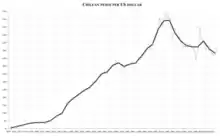Chilean cent
The Chilean cent (Centavo Chileno in Spanish) was the subdivision of the Chilean peso from 1975 to 1983.
| Chilean cent | |
|---|---|
| Centavo Chileno (Spanish) | |
 Picture of a 50-cent coin | |
| ISO 4217 | |
| Code | CLP |
| Denominations | |
| Coins | 1, 5, 10, 50 |
| Demographics | |
| Date of introduction | 1975 |
| Date of withdrawal | 1983 |
| User(s) | Chile |
| Issuance | |
| Central bank | Banco Central de Chile |
| Website | www |
| Mint | Casa de Moneda |
| Website | www |
| Valuation | |
| Pegged with | 1 Chilean peso = 100 centavos |
It was a subdivision of the first Chilean peso until it was replaced by the Chilean escudo.
It was pegged to the Chilean peso, 100 cents being worth around 1 peso, which was worth much more than it is in 2020.[1]
It was first minted in 1975 when the Chilean escudo was replaced by the peso, and the cent came with it.
At the beginning of the currency's life, a Chilean cent was worth the same as a penny, but due to Chilean inflation by the third year as a coin, the Chile cent was worth only half a penny.
Due to Chilean hyperinflation, the Chilean cent's value decreased tremendously, being worth nearly 1/100 as much as when it was introduced, in 1983 the Chilean government realized that they weren’t worth minting and were discontinued; they stayed in circulation for around a decade until it was impossible to find one.
The Chilean cent is now a rare collector’s item, with a value of 0.0000013 USD per cent, the highest denomination, the 50-cent coin being worth 0.00006 dollars.[2]
Design
The design on the obverse of all the coins look very similar to the modern coin in circulation, with the denomination in big numbers, and the name of the currency under the denomination, with the year it was minted being under the name of the currency. The reverse on all coins depicts a condor, the national bird of Chile, standing on top of a rock with its wings semi-open as if it were warming its body up, the image of the condor used in the reverse is the same as the design of the reverse of the coins of the first peso.
The 1 and 50 cent coins are shaped like a circle while the 5 and 10 are in the shape of a dodecagon.
The first 3 coins, the 1,5, and 10 were originally made of aluminium, but the 5 and 10 later changed to aluminium bronze. The highest denomination is made from the same material as the 5 and 10 peso coins, aluminium bronze, which looks like gold.[3]
History
After the Escudo was replaced by the second peso, the one used by chile today, the Centavo has revived to be the subunit of the Chilean peso with a value similar to the American Penny. The "Centavo" was valued by the Chilean peso, 100 cents was 1 peso.[4]
But due to instant hyperinflation, the peso was devalued at a rapid rate, due to the cent being pegged to the peso, when the peso was devalued the cent was devalued as well. This is the way most currencies lose their subunits, for example, the same thing happened to the Argentine peso.


Within 3 years, a Chilean cent was worth half of what it used to be, it was still used in transactions but many people started to notice that the cent was starting to lose value rapidly, even though inflation was making the value of the centavo was dropping massively they were still available to be used in legal transactions without being a hassle to use.
Inflation buried the Chilean cent, and in 1983 it cost the government more to make the coin then what they were worth, on 1983 the Chilean cent was discontinued, with its highest denomination, the 50 cent coin only being worth 1/1000 of a US dollar, by the year it was withdrawn, 6500 centavos were worth around 1 dollar.
As of 2020 a Chilean cent is worth around 0.0000013 USD, not being in circulation for decades the Chilean cent has turned into a collector’s item.
References
- "Historic inflation Chile – historic CPI inflation Chile". www.inflation.eu. Retrieved 2020-10-30.
- "CLP - Chilean Peso rates, news, and tools". www.xe.com. Retrieved 2020-10-30.
- "Chile coins catalog with images and values, currency prices, Chile pesos". worldcoinsinfo.com. Retrieved 2020-12-11.
- Mky76 (2012-06-11). "Dragon de Agua: HISTORIA MONEDAS Y BILLETES CHILENOS". Dragon de Agua. Retrieved 2020-12-02.